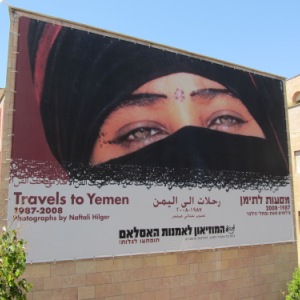If you could get in a boat in Eilat and sail south on the Red Sea to the tip of the Arabian Peninsula, you would arrive in the Republic of Yemen, a nation rich with oil reserves but with a population that is one of the poorest on earth. Yemen, a colorful land that played an important home to Jews throughout the ages, has recently been in the headlines due to its role in the Arab Spring protests.
The L.A. Mayer Museum for Islamic Art in Jerusalem is hosting a stunning photographic exhibition entitled “Travels to Yemen 1987 - 2008”. The lens of renowned Israeli photographer Naftali Hilger’s camera offers a rare glimpse into a society caught far behind the rest of the world.
The first thing you notice in the photographs is the unique architecture of the old town of Sana’a, the capital city. Recognized by UNESCO as a World Heritage Site, the crowded streets are lined by eight-story "skyscrapers" of stone and mud. Each family’s livestock is kept in the lowest levels, the bedrooms are in the middle, and the common rooms are at the top, where family members sit around chewing qat.
Yemen, one learns, used to be self-sufficient in food production and its mountain slopes were naturally irrigated by two annual rainy seasons. In recent years, the only crop grown extensively is qat. In the morning hours, men flock to the city markets to make purchases of the leaves of this stimulant, and in the afternoons the entire country seems to go into a daze due to qat chewing.
The photographs highlight the artwork on the Yemenite buildings; in many cases there are stars of David marking the former Jewish residents of the city. Most of Yemen’s Jews were airlifted to Israel in 1949, but a handful remained. Today the last of Yemen’s Jews are affiliated with the ultra-Orthodox Satmar sect.
The impression one gets of Yemen from the photographic exhibition is that it is a country caught in the past, despite the fact that its residents have exchanged daggers and swords for Kalashnikov rifles.
The L.A. Mayer Museum for Islamic Art, located on HaPalmach Street just a short distance away from the Jerusalem Theater, is an off-the-beaten path destination for Jerusalem visitors. Opened in 1974, it has an excellent collection of Islamic art, weaponry, everyday household items, jewelry, silver objects and more from the different Islamic periods.
The museum is also well-known for its collection of watches and clocks. The Sir David Salomons collection includes many colorful timepieces made by Abraham Louis Breguet (1747-1823), inventor of some of the greatest technological innovations in modern watch-making.
In 1983, 106 timepieces including a pocket watch made for French queen Marie Antoinette were stolen from the museum, and in fact, on my last visit a few years ago, the clock room still had nothing in it to display. The case of the theft was cracked only in 2008 and most of the museum pieces have been returned and are again available for viewing.
It's worthwhile visiting the Museum for Islamic Art, because no matter what part of the collection you enjoy, you're guaranteed to be transported to fascinating worlds unknown.

No comments:
Post a Comment